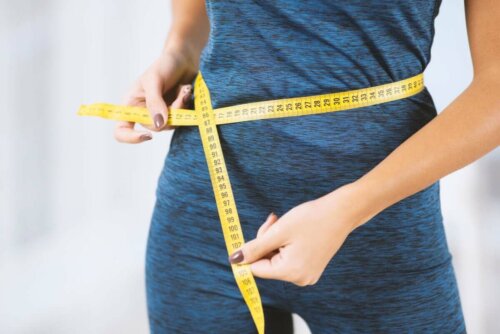The Optimal Size of the Abdominal Circumference


Reviewed and approved by the doctor Elisa Martin Cano
Abdominal circumference matters beyond aesthetics. This is because accumulated fat in this area of the body is a cardiovascular risk factor. All you have to do to determine yours is measure yourself around the waist, at the level of the navel.
OK, but what’s the limit we shouldn’t exceed in the abdominal circumference? The World Health Organization (WHO) establishes that the measurement shouldn’t exceed 35 inches in women and 40 inches in men.
The risks of having a larger abdominal circumference
The cardiovascular risk alert goes off when you’re obese. Meanwhile, the risk skyrockets if the abdominal circumference exceeds the measures considered healthy. This is because it denotes an increase in circulatory problems.
There’s a real danger of heart disease when the extra pounds are evenly distributed in different parts of the body. However, it increases when the abdominal area accumulates more fat than other body regions. This is because intra-abdominal fat tissue contains cells, called adipocytes, which produce a certain amount of hormones with a high metabolic value.
Such adipocytes release free fatty acids, which the liver metabolizes and uses for energy instead of glucose. Consequently, any sugar not used by the liver remains in the body and increases. This process increases blood lipids and blood glucose levels go really high.
When you see it like this you’ll understand why a bulging abdomen is a problem that goes beyond mere aesthetics. This is because it can lead to metabolic syndrome, characterized by an increase in bad cholesterol and triglycerides. This in addition to a decrease in good cholesterol, an increase in blood pressure, and hyperglycemia.

Read about The Four Most Fattening Foods
How to measure correctly
A tape measure and some tips are all you need to take measurements of your abdominal circumference. Doctors usually do this during a routine medical checkup. They also do it when they notice an increase in body mass index (BMI) that indicates excess weight.
You must stand upright, with your arms at your sides to correctly measure your abdominal circumference. Then loosen your belt, if any, and remove any garment that covers your torso in order to measure around the skin at the level of the navel.
Place the tape measure below the rib cage and above the top of the hip bone. Relax the abdomen. Then, exhale before putting the measuring tape around. Write down the figures immediately so as not to lose your information.
Check out these Exercises for Abdominals without Hurting Your Back
Types of obesity according to abdominal circumference
There are two types of obesity, depending on the location of the excess fat.
- The first one is peripheral obesity. This is when the adiposity is located in the thighs, buttocks, and hips.
- The other one is central obesity. This is when the excess fat is almost exclusively at the level of the abdominal circumference.
People with central obesity are twice at risk of suffering from cardiovascular diseases. However, keep in mind that excess fat is always harmful, regardless of its location.
- In addition, there’s android or apple-shaped obesity when there’s more abdominal or visceral fat.
- Also, the obesity caused by accumulation in the arms, legs, and hips is referred to as gynoid or pear-shaped obesity.
There are some important organs located in the area of the abdominal circumference: the liver, stomach, spleen, and gallbladder. These are the ones that suffer from the activity of this localized fat. In the case of women, the hormonal changes during menopause contribute to changes in body structure.

What to do if your abdominal circumference is larger than it should be?
You must adopt a healthy lifestyle in order to avoid an increase in your abdominal circumference. Professionals recommend aerobic exercises combined with strength exercises. This is because the former contribute to the expenditure of calories while the latter tone the muscles and improve your body posture.
Eating a healthy diet, free of saturated fat and simple sugars, helps control weight. In addition, this type of diet is good for your heart. In addition, hydration is an important factor as it helps prevent fluid retention. Also, proper rest relieves stress and improves hormonal function.
Finally, body posture is important so try not to sit for several hours at a time. This is because the curved spine sitting position relaxes the abdominal muscles and promotes the consequent accumulation of fat in this area. Thus, do medical check-ups at least once a year so your doctor can keep track of your abdominal circumference and certify whether it decreased or not.
All cited sources were thoroughly reviewed by our team to ensure their quality, reliability, currency, and validity. The bibliography of this article was considered reliable and of academic or scientific accuracy.
- Moreno González, M. I. (2010). Circunferencia de cintura: una medición importante y útil del riesgo cardiometabólico. Revista chilena de cardiología, 29(1), 85-87.
- Aguilar, N. C. M., & Cáceres, V. A. S. (2016). Obesidad Central y Obesidad Periférica como Factor de Asociación de Hipertensión Arterial en Escolares Adolescentes de los Principales Colegios de la Ciudad de Chiclayo. Revista Experiencia en Medicina del Hospital Regional Lambayeque: REM, 2(2), 44-49.
- Remón Popa, I., González Sotolongo, C., & Arpa Gámez, Á. (2013). Estimación del punto de corte de la circunferencia abdominal como criterio diagnóstico del síndrome metabólico. Revista Cubana de Medicina Militar, 42(1), 29-38.
- Chambilla, Mari Carrión, et al. “Índice de masa corporal, circunferencia abdominal y su impacto en los niveles de presión arterial.” Revista Diagnostico 46.1 (2007).
- Johnson, Steven T., et al. “Metabolic risk varies according to waist circumference measurement site in overweight boys and girls.” The Journal of pediatrics 156.2 (2010): 247-252.
- Ramírez, Robinson, and Ricardo A. Agredo. “El sedentarismo es un factor predictor de hipertrigliceridemia, obesidad central y sobrepeso.” Revista Colombiana de Cardiología 19.2 (2012): 75-79.
- Pavón de Paz, I., C. Alameda Hernando, and J. Olivar Roldán. “Obesidad y menopausia.” Nutrición Hospitalaria 21.6 (2006): 633-637.
- Siqueira, Gisela Rocha de, and Giselia Alves Pontes da Silva. “Alterações posturais da coluna e instabilidade lombar no indivíduo obeso: uma revisão de literatura.” Fisioterapia em movimento 24.3 (2011): 557-566.
- Jorquera, A. Carlos, and L. Jorge Cancino. “Ejercicio, obesidad y síndrome metabólico.” Revista Médica Clínica Las Condes 23.3 (2012): 227-235.
This text is provided for informational purposes only and does not replace consultation with a professional. If in doubt, consult your specialist.








